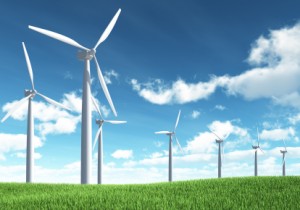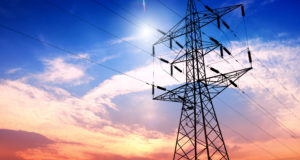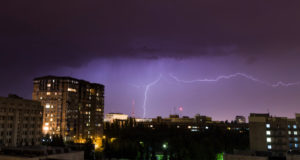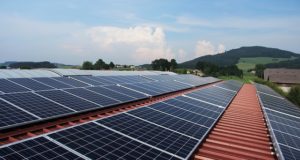 Everyone is familiar with that old axiom from the housing real estate market about the importance of “location, location, location.” This principle goes double for a wind power system, which will not function effectively unless it is placed in the proper spot. To some extent of course this is obvious, as common sense will tell you that a wind turbine must be set up in a location where the wind will actually be able to reach it. This does not mean a wind turbine can just be put up any old place where the wind might happen to be blowing, however – a wind power system does represent a fairly significant financial investment, which is why you will want to make sure that you can milk every last bit of power out of your turbine that it is capable of delivering by picking the perfect location for its installation.
Everyone is familiar with that old axiom from the housing real estate market about the importance of “location, location, location.” This principle goes double for a wind power system, which will not function effectively unless it is placed in the proper spot. To some extent of course this is obvious, as common sense will tell you that a wind turbine must be set up in a location where the wind will actually be able to reach it. This does not mean a wind turbine can just be put up any old place where the wind might happen to be blowing, however – a wind power system does represent a fairly significant financial investment, which is why you will want to make sure that you can milk every last bit of power out of your turbine that it is capable of delivering by picking the perfect location for its installation.
Wind turbine siting is actually a pretty precise science. Like any other type of science, it can get a little complicated at times, but that does not mean it takes a Ph.D. to figure things out. You will need to put some thought and effort into the process, however, if you expect to find the perfect site that will allow you to mount a wind turbine that can effectively and efficiently harvest the immense energy potential of the air that is swirling and sweeping around and above us each and every day.
Inheriting The Wind
Wind is everywhere, and as a source of energy, it can be exploited with a surprising degree of cost efficiency. However, capturing the bountiful energy that the wind is capable of providing will only be possible if the wind tower and turbine are placed in a location that is free and clear of anything that can interfere with the natural flow of the air as it moves across the surrounding landscape.
In order to reach the wind where it blows most freely and strongly, the entire rotor of a wind turbine should be elevated at least 30 feet above the tallest obstacle within a 500-foot radius of the mounting tower. When working within these guidelines, tree growth is one factor that must be taken into account, so if you have trees on your property you should estimate how much they can be expected to grow over the next 20 to 30 years (the expected life span of a wind power system). If these estimates lead you to believe those trees will eventually be the tallest objects on your property, you should perform your turbine height calculations accordingly.
There are two exceptions to the 30-500 rule, and these are also based on tree-related issues. First, if there is a continuous plot of forest land within a quarter of a mile of the planned wind turbine site, the 500-foot radius will need to be expanded so the height of the tree line there can be factored into your height-determining equation. The second exception applies if more than 50 percent of the area within your 500-foot zone is covered by deciduous trees. When this is the case, the tallest trees will need to be measured in feet, and 2/3 of this value will then be added to the normal 30-foot elevation requirement. So if, for example, the tallest trees on a plot of land reached an elevation of 45 feet, the entire rotor of the wind turbine would need to be lifted to a height that is at least 60 feet above the ground (the original 30 + 2/3(45) = 60).
Wind rose charts give detailed information about the prevailing speed and directionality of the winds in particular geographical locations, broken down by month, and this is information you will want to have before you begin the process of mounting your turbine. There are a few different places where this information can be found online; one excellent source is the website of the National Water and Climate Center, which is a part of the U.S. Department of Agriculture. They offer links to charts for all 50 states and for most regions within those states, so in most instances you should be able to find all the data you need for the area where you live. Knowing the speed of the prevailing winds in your area will allow you to accurately calculate how much energy your wind system can reasonably be expected to produce, and directionality can be an issue as well if there are geographical features outside your 500 foot radius that may be large enough to interfere with the normal free flow of air (i.e. large hills, bluffs, mountains, multi-story buildings if you are fairly close to a populated area, etc.). You also need to keep in mind that most turbines require wind speeds in the 8 to 10 mph range before they can be expected to move and generate any energy at all.
A Simple Guide to Creating and Maintaining a Self-reliant Supply of Energy, Water, Shelter and More
Generally speaking, you will want to locate your wind turbine as close as possible to the place where the power collected will actually be used. When the wire that must be run from the tower to the rest of the wind system is minimized, it will reduce the amount of power that is wasted through line loss, which is an inevitable feature of any wind set-up, no matter how well designed and efficient it might be.
Your local or state zoning laws could provide one potential complication to your plans for a wind power system. There may be regulations in your area that will not allow you to install a turbine within a certain distance of your neighbor’s property, at least not without his or her permission, so you will need to check out the local rules first before proceeding with the actual installation of your system.
The Magic Equation
Once you have selected a site, and you know how high your turbine tower will need to be to fully exploit the wind in your area, you can then begin to make the calculations that will let you know just how much energy you can expect any wind power system you put in to produce.
Here is the magic equation that will give you the critical data you need:
Annual Output (KWH/year) = 0.01328 (D^2) (V^3)
In this formula, D^2 equals the blade diameter of the turbine in feet squared, while V^3 equals wind velocity cubed expressed in miles per hour.
The first thing that becomes immediately apparent when analyzing this equation is that wind speed is the most important factor in determining how many kilowatt hours a wind turbine can be expected to produce over one year (wind speed cubed produces a much larger number than blade diameter squared). This is why it is so essential to pick a wind turbine site where your exposure to unimpeded air flow will be guaranteed, and to make sure you get your turbine up high enough to catch the wind at its natural peak velocity.
It is important to know the total energy your system will be able to produce annually, but you will also have to study the month-by-month data from your local wind rose chart quite carefully. Your will want to know how time-related variations might effect the amount of energy your system can provide from season to season, so you will know if it will be necessary to add supplemental sources of power to help out your wind energy set-up during certain parts of the year.
The Answer Is Blowing In The Wind
Your final calculations will involve a cost-benefit analysis that will help you determine whether or not a wind system is really right for you. If you know how much energy the system (or systems) you are considering will actually produce, once they have been properly sited and mounted on your land, you can then figure out exactly how much power you can expect to obtain over the course of a wind system’s life span for each dollar you will have to spend on the turbine, the tower, and all the other parts of your wind energy set-up.
Once you have done the math, it is entirely conceivable you will discover that the wind energy systems you have been looking at will not be able to pay for themselves in a reasonable amount of time, and therefore it would not be in your best interest to install a wind turbine on your property at this time. Even if you have come up with what you believe is the perfect site for a turbine, that is no guarantee that wind energy will ultimately prove to be the ideal choice for you.
But then again, you may find out, much to your surprise, that an affordable wind energy system will be able to meet most if not all of your personal energy needs – in which case, all the work you put in finding the best available site for a wind turbine on your property will have been well worth the time and effort you chose to invest.
©2012 Off the Grid News
 Off The Grid News Better Ideas For Off The Grid Living
Off The Grid News Better Ideas For Off The Grid Living




